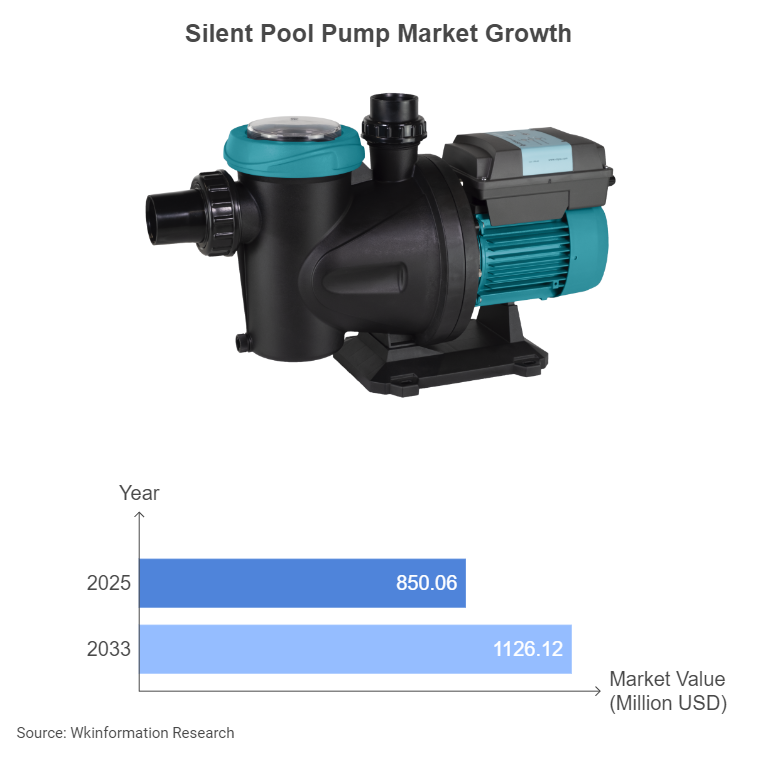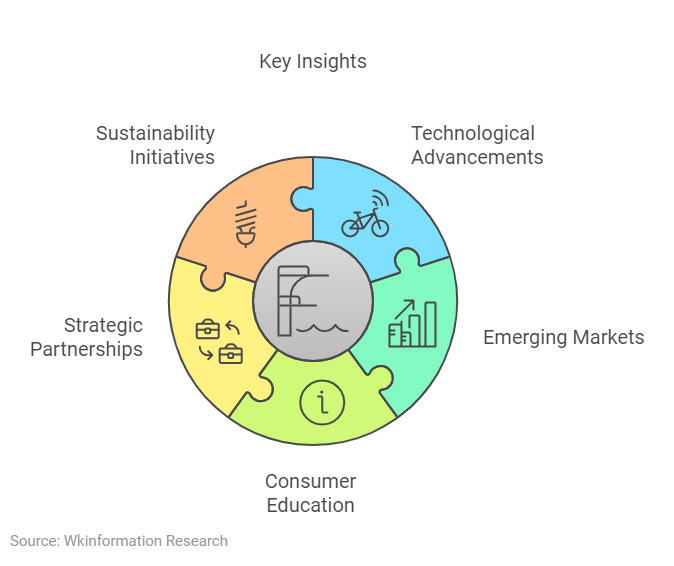
The silent pool pump market is experiencing a transformative phase, driven by the increasing demand for energy-efficient solutions and the growing construction of swimming pools in urban areas. The silent pool pump market is expected to reach USD 850.06 Million in 2025 and is expected to grow to USD 1126.12 Million in 2033, with a CAGR of 3.58% from 2025 to 2033. Silent pool pumps, known for their noise reduction capabilities, are becoming essential in residential and commercial settings. Understanding market trends and growth factors is crucial for stakeholders aiming to capitalize on future opportunities. With projections indicating significant growth, particularly in developing regions, the market presents a promising landscape for innovation and investment.
Key Insights
- The silent pool pump market is growing rapidly due to increasing demand for energy-efficient and quiet solutions, particularly in urban areas.
- Technological advancements, such as smart technology and inverter systems, are enhancing the performance and convenience of modern pool pumps.
- Emerging markets present significant opportunities for growth, driven by urbanization and rising disposable incomes, making affordable silent pool pumps essential.
- Consumer education on the benefits of silent and energy-efficient pumps is crucial for overcoming market barriers and boosting demand.
- Strategic partnerships with technology and construction firms can drive innovation and expand market reach, benefiting manufacturers and consumers alike.
- Sustainability initiatives are becoming increasingly important, with eco-friendly pool pumps appealing to environmentally conscious consumers.

Market Overview

Key Takeaways
The silent pool pump market is undergoing significant changes, reflecting broader trends in the swimming pool pumps market. The demand for energy-efficient and quiet pool pumps is on the rise, driven by consumer preferences for reduced noise pollution and enhanced energy savings. This market is poised for growth, with projections indicating a substantial increase in market size over the coming years. The integration of smart technology and inverter technology in modern pool pumps is a key trend, offering improved performance and user convenience. These advancements are not only meeting current consumer demands but also paving the way for future innovations in water circulation and filtration systems.
Market Drivers
Several factors are propelling the growth of the swimming pool pumps market. Firstly, the increasing construction of swimming pools in urban areas is a major driver. As more residential and commercial properties incorporate pools, the demand for efficient and silent pool pumps rises. Secondly, there is a growing consumer preference for energy-efficient home devices. Silent pool pumps, with their advanced inverter technology, offer significant energy savings, making them an attractive choice for environmentally conscious consumers. Lastly, the integration of smart technology in pool pumps is enhancing their appeal. Features such as IoT capabilities allow users to monitor and control their pool systems remotely, adding convenience and efficiency.
Market Restraints
Despite the positive outlook, the pool pump market faces certain challenges. High initial costs of advanced silent pool pumps can deter potential buyers, particularly in price-sensitive markets. Additionally, the complexity of integrating smart technology into existing pool systems may pose a barrier for some consumers. There is also a need for increased awareness about the benefits of silent and energy-efficient pool pumps. Many consumers remain unaware of the long-term cost savings and environmental benefits these pumps offer. Addressing these restraints will be crucial for market players aiming to expand their reach and capitalize on emerging opportunities.
By seizing these opportunities, industry players can position themselves for success in the evolving silent pool pump market.
Market Segment Analysis
By Type
Variable Speed Pumps
Variable speed pumps have revolutionized the swimming pool pumps market. These pumps offer unparalleled energy efficiency by allowing users to adjust the pump’s speed according to their specific needs. This flexibility not only reduces energy consumption but also extends the lifespan of the pump. As a result, variable speed pumps have become the preferred choice for many pool owners. In fact, over 60% of pool owners in residential areas now opt for quieter models, highlighting the growing demand for silent pool pumps. The ability to fine-tune the pump’s operation ensures optimal water circulation and filtration, enhancing overall pool pump performance.
Single Speed Pumps
Single speed pumps, while less flexible than their variable counterparts, remain a staple in the swimming pool pumps market. These pumps operate at a constant speed, providing consistent performance. They are often more affordable, making them an attractive option for budget-conscious consumers. However, the lack of speed variability can lead to higher energy consumption. Despite this, single speed pumps continue to serve as reliable options for those seeking straightforward solutions without the need for advanced features.
By Application
Residential
In residential settings, the demand for high-performing pool pumps is on the rise. Homeowners prioritize energy efficiency and noise reduction, with younger homeowners particularly valuing modern technology and eco-friendliness. Silent pool pumps, equipped with advanced inverter technology, meet these demands by offering quiet operation and significant energy savings. As urbanization increases, more residential properties incorporate swimming pools, further driving the need for efficient pool pump solutions.
Commercial
Commercial applications require robust and reliable pool pumps capable of handling larger volumes of water. Variable speed pumps excel in these environments, providing the necessary power and efficiency to maintain optimal water quality. The integration of smart technology allows facility managers to monitor and control pool systems remotely, ensuring seamless operation. As commercial establishments continue to expand their amenities, the demand for advanced pool pump solutions will likely grow.
By Region
North America
North America remains a significant player in the pool pump market. The region’s focus on energy efficiency and sustainability drives the adoption of variable speed pumps. Consumers in this region value advanced technology and are willing to invest in high-quality pool equipment.
Europe
Europe’s emphasis on environmental conservation aligns with the growing popularity of silent pool pumps. The region’s stringent regulations on energy consumption encourage the use of variable speed pumps, which offer substantial energy savings.
Asia-Pacific
The Asia-Pacific region presents immense growth potential for the silent pool pump market. Rapid urbanization and increasing disposable incomes contribute to the rising demand for residential and commercial swimming pools. Manufacturers can capitalize on this trend by offering affordable and efficient pool pump solutions tailored to local needs.
Latin America
Latin America’s expanding tourism industry fuels the demand for commercial pool pumps. Hotels and resorts seek reliable and efficient solutions to maintain their swimming facilities. Variable speed pumps, with their energy-saving capabilities, are well-suited to meet these requirements.
Middle East & Africa
The Middle East & Africa region experiences a growing interest in luxury amenities, including swimming pools. As the construction of high-end residential and commercial properties continues, the demand for advanced pool pump solutions will likely increase. Manufacturers can explore opportunities to introduce innovative products that cater to the region’s unique climate and consumer preferences.
Key Trends
Energy Efficiency
The swimming pool pumps market is witnessing a significant shift towards energy efficiency. Consumers increasingly demand energy-efficient pumps that reduce operational costs and minimize environmental impact. Manufacturers have responded by developing energy-efficient motors that optimize pool pump performance. These motors adjust their speed to match the pool’s requirements, ensuring effective water circulation and filtration while conserving energy. This trend not only benefits consumers by lowering electricity bills but also aligns with global sustainability goals.
Smart Technology Integration
Smart technology integration is revolutionizing the swimming pool pumps market. Modern pumps now feature IoT capabilities, allowing users to control and monitor their systems remotely. This advancement enhances user convenience and ensures optimal pool pump performance. By integrating smart technology, manufacturers provide consumers with the ability to customize settings, receive maintenance alerts, and track energy usage. This level of control empowers pool owners to maintain their pools efficiently and effectively, further driving the demand for energy-efficient motors.
Silent Operation Features
The demand for quiet operation in pool pumps is on the rise. Consumers prioritize a serene environment, especially in residential and commercial settings. Silent pool pumps address this need by incorporating advanced noise reduction technologies. These pumps operate with minimal sound, ensuring a peaceful atmosphere for pool users. The focus on quiet operation not only enhances user experience but also complies with local noise regulations. As a result, manufacturers continue to innovate, creating pumps that deliver both high-performing pool pumps and energy efficiency.
Business Opportunities
Emerging Markets
Emerging markets present a fertile ground for growth in the swimming pool pumps market. As urbanization accelerates in developing regions, the demand for residential and commercial swimming pools increases. This trend creates a significant opportunity for manufacturers to introduce energy-efficient pumps that cater to the specific needs of these markets. By offering affordable and efficient solutions, companies can tap into the growing consumer base seeking modern amenities. The emphasis on energy efficiency aligns with global sustainability goals, making these markets attractive for long-term investment.
Technological Innovations
Technological advancements continue to drive the evolution of the swimming pool pumps market. Manufacturers are focusing on integrating cutting-edge features such as variable-speed motors and intelligent control systems. These innovations enhance pool pump performance by allowing users to adjust the pump’s speed according to their specific needs. This flexibility not only reduces energy consumption but also extends the lifespan of the pump. Variable-speed pumps, for instance, can reduce energy consumption by up to 90%, offering substantial savings on utility bills. The incorporation of smart technology further empowers consumers by providing remote monitoring and control capabilities, ensuring optimal energy efficiency and quiet operation.
Strategic Partnerships
Strategic partnerships offer a pathway to success in the competitive swimming pool pumps market. Collaborations with technology firms and construction companies can drive innovation and expand market reach. By forming alliances, manufacturers can leverage expertise and resources to develop superior products that meet evolving consumer demands. These partnerships also facilitate entry into new markets and enhance distribution networks. Additionally, joint ventures with environmental organizations can promote the adoption of energy-efficient pumps, aligning with the growing emphasis on sustainability. Through strategic collaborations, industry players can strengthen their market position and capitalize on emerging opportunities.
Competitive Landscape

Major Market Players
- Hayward Industries
- Supreme Heating
- Boss Solar
- Madimack
- Pentair
- Onga
- Aquagem
- Davey Silensor
- AstralPool
- SPLASH POOL&SPA
- Guangdong Weilangshi
- Zhejiang Cipu Pool&spa Technology
- Guangzhou Qianye Water Equipment
- Fairland Holdings
Market Share Analysis
In the swimming pool pumps market, major players hold a significant share due to their established brand reputation and extensive distribution networks. Pentair and Hayward Industries, for instance, have captured a substantial portion of the market by consistently delivering high-quality and reliable pool pumps. Their commitment to innovation and customer satisfaction has solidified their positions as leaders in the industry. Smaller companies, however, are also making strides by focusing on niche markets and offering specialized products that cater to specific consumer needs. This competitive dynamic ensures a diverse range of options for consumers, fostering healthy competition and driving further advancements in the pool pump market.
Recent Developments
Recent developments in the silent pool pump market highlight the industry’s focus on technological innovation and strategic partnerships. Leading manufacturers are investing heavily in research and development to introduce cutting-edge features, such as variable-speed motors and IoT capabilities, into their products. These advancements not only enhance pool pump performance but also provide users with greater control and convenience. Additionally, companies are forming alliances with technology firms and construction companies to expand their market reach and develop superior products. These collaborations facilitate entry into new markets and strengthen distribution networks, ensuring that manufacturers remain competitive in an ever-evolving industry landscape.
Overview
The silent pool pump market holds immense potential, driven by the increasing demand for energy-efficient pumps and quiet operation. Companies like Pentair, Hayward, and Fairland Holdings lead the charge with continuous innovation and strategic partnerships. The focus on energy efficiency aligns with global sustainability goals, offering a promising direction for the industry. As technology advances, the market will likely see further growth, particularly in emerging regions. The future outlook for the silent pool pump industry appears bright, with opportunities for expansion and innovation continuing to unfold.
| Report Attributes | Details |
|---|---|
| Base Year | 2024 |
| Market Size 2025 | 850.06 Million USD |
| Market Size 2033 | 1126.12 Million USD |
| CAGR | 3.58% |
| Historical Year | 2019 – 2024 |
| Forecast Year | 2025 – 2033 |
| Report Coverage | Revenue Forecast, Market Competitive Landscape, Growth Factors, and Trends |
| Segments Covered | Type, Applications, and Region |
| Geographies Covered | North America, Europe, Asia Pacific, and the Rest of the World |
FAQ
What is driving the growth of the silent pool pump market?
The silent pool pump market is experiencing growth due to several factors. The increasing demand for energy-efficient solutions and the rising construction of swimming pools in urban areas are significant drivers. Consumers prefer quieter pool pumps to reduce noise pollution, which further boosts market demand. Additionally, the integration of smart technology in modern pool pumps enhances their appeal by offering convenience and improved performance.
How do variable speed pumps differ from single speed pumps?
Variable speed pumps offer greater energy efficiency compared to single speed pumps. They allow users to adjust the pump’s speed according to specific needs, reducing energy consumption and extending the pump’s lifespan. Single speed pumps operate at a constant speed, providing consistent performance but often consuming more energy. Variable speed pumps have become the preferred choice for many pool owners due to their flexibility and cost-saving benefits.
What are the main challenges facing the silent pool pump market?
The silent pool pump market faces several challenges. High initial costs of advanced pumps can deter potential buyers, especially in price-sensitive markets. The complexity of integrating smart technology into existing systems may also pose a barrier. Additionally, there is a need for increased consumer awareness about the long-term benefits of silent and energy-efficient pool pumps. Addressing these challenges is crucial for market players aiming to expand their reach.
What opportunities exist for manufacturers in the silent pool pump market?
Manufacturers can capitalize on numerous opportunities in the silent pool pump market. Emerging markets offer significant potential for expansion as urbanization increases demand for swimming pools. Technological innovations, such as enhanced inverter technology and IoT capabilities, provide fertile ground for product development. Strategic partnerships with technology firms and construction companies can drive growth and facilitate entry into new markets.
How does smart technology integration benefit pool pump users?
Smart technology integration in pool pumps offers several benefits to users. It allows for remote monitoring and control of pool systems, enhancing user convenience and ensuring optimal performance. Users can customize settings, receive maintenance alerts, and track energy usage. This level of control empowers pool owners to maintain their pools efficiently, aligning with the growing demand for energy-efficient and user-friendly solutions.
Which regions show the most potential for market growth?
The Asia-Pacific region presents immense growth potential for the silent pool pump market. Rapid urbanization and increasing disposable incomes contribute to the rising demand for swimming pools. North America and Europe also remain significant players, driven by a focus on energy efficiency and sustainability. Latin America’s expanding tourism industry and the Middle East & Africa’s interest in luxury amenities further fuel market growth.
What role do strategic partnerships play in the market?
Strategic partnerships play a crucial role in the silent pool pump market. Collaborations with technology firms and construction companies drive innovation and expand market reach. These alliances allow manufacturers to leverage expertise and resources to develop superior products. Joint ventures with environmental organizations can promote the adoption of energy-efficient pumps, aligning with global sustainability goals.
How do recent developments impact the silent pool pump market?
Recent developments in the silent pool pump market highlight the industry’s focus on technological innovation and strategic partnerships. Leading manufacturers invest heavily in research and development to introduce cutting-edge features, such as variable-speed motors and IoT capabilities. These advancements enhance pool pump performance and provide users with greater control and convenience. Strategic collaborations facilitate entry into new markets and strengthen distribution networks, ensuring competitiveness in an evolving industry landscape.
What is the future outlook for the silent pool pump industry?
The future outlook for the silent pool pump industry appears promising. The increasing demand for energy-efficient pumps and quiet operation drives market growth. Companies like Pentair, Hayward, and Fairland Holdings lead the charge with continuous innovation and strategic partnerships. As technology advances, the market will likely see further growth, particularly in emerging regions. Opportunities for expansion and innovation continue to unfold, offering a bright future for the industry.
Global Silent Pool Pump Market Report – Table of Contents
1 Market Study Overview
2 Basic Product Information
3 Market Analysis
4 Silent Pool Pump Related Market Analysis
5 Global Trend Summary
6 Competition by Manufacturer
7 Analysis of Key Players
8 Global Silent Pool Pump Revenue, Sales Categorized by Regions
9 North America Silent Pool Pump Market Size Categorized by Countries
10 Europe Silent Pool Pump Market Size Categorized by Countries
11 Asia-pacific Silent Pool Pump Market Size Categorized by Countries
12 South America Silent Pool Pump Market Size Categorized by Countries
13 Middle East and Africa Silent Pool Pump Market Size Categorized by Countries
14 Global Silent Pool Pump Industry Segment Analysis
15 Global Silent Pool Pump Market Forecast
16 Research Findings and Conclusion
17 Appendix


